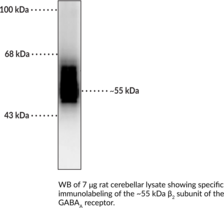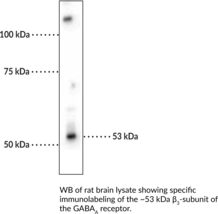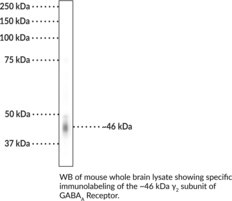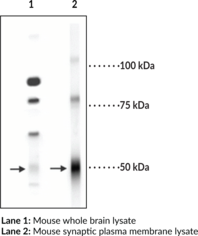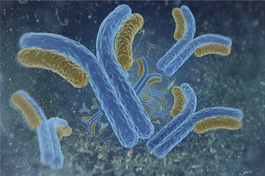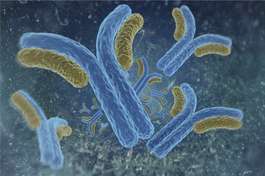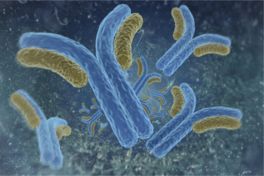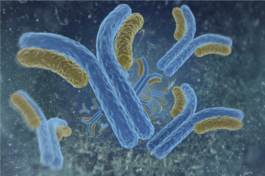Cayman
Showing 21451–21600 of 45550 results
-
Immunogen: Fusion protein from the cytoplasmic loop of the β2 subunit of the rat GABAA receptor • Host: Rabbit • Species Reactivity: (+) Mouse, Rat • Cross Reactivity: None provided • Applications: WB • MW = ~55 kDa
Brand:CaymanSKU:29274- 100 µlAvailable on backorder
Immunogen: Fusion protein from the cytoplasmic loop of the β3 subunit of the rat GABAA receptor • Host: Rabbit • Species Reactivity: (+) Mouse, Rat • Applications: IHC, WB • MW = ~53 kDa
Brand:CaymanSKU:29275- 100 µlGABAA receptors are ligand-gated chloride channels that mediate the effects of the inhibitory neurotransmitter GABA in the CNS.{46949,46950} They are postsynaptic heteropentameric receptors that contain protein subunits from the following isoforms: α1-6, β1-4, γ1-3, δ, ε, π, θ, and ρ1-3, arranged around a central pore. Phasic inhibitory synaptic transmission is regulated by α1β2γ2 subunit-containing GABAA receptors, the major isoform found in the brain.{46950,46951} The β subunit of GABAA receptors interfaces with an α subunit to form the GABA binding site that initiates GABA-induced action potentials and forms the benzodiazepine binding site with the γ subunit. β3 subunit-containing GABAA receptors are widely expressed in the cerebral cortex, cerebellum, olfactory bulb, and hippocampus.{55098} Phosphorylation of the β3 subunit by PKA or PKC inhibits binding of the β3 subunit with the clathrin adaptor protein AP2 and reduces GABAA receptor endocytosis.{55097} Mutations in GABRB3, which encodes the β3 subunit isoform, have been found in patients with childhood absence epilepsy (CAE), infantile spasms (IS), and Lennox-Gastaut syndrome (LGS).{46950} Cayman’s GABAA Receptor β3 Subunit Polyclonal Antibody can be used for immunohistochemistry (IHC) and Western blot (WB) applications. The antibody recognizes the GABAA receptor β3 subunit at approximately 53 kDa from rat and mouse samples.
Brand:CaymanSKU:29275 - 100 µlAvailable on backorder
Immunogen: Fusion protein from the cytoplasmic loop of the β3 subunit of the rat GABAA receptor • Host: Rabbit • Species Reactivity: (+) Mouse, Rat • Applications: IHC, WB • MW = ~53 kDa
Brand:CaymanSKU:29275- 100 µlAvailable on backorder
Immunogen: Fusion protein from the cytoplasmic loop of the γ2 subunit of the rat GABAA receptor • Host: Rabbit • Species Reactivity: (+) Mouse, rat • Applications: IHC, WB • MW = ~46 kDa
Brand:CaymanSKU:29276- 100 µlGABAA receptors are ligand-gated chloride channels that mediate the effects of the inhibitory neurotransmitter GABA in the CNS.{46949,46950} They are postsynaptic heteropentameric receptors that contain protein subunits from the following isoforms: α1-6, β1-4, γ1-3, δ, ε, π, θ, and ρ1-3, arranged around a central pore. Phasic inhibitory synaptic transmission is regulated by α1β2γ2 subunit-containing GABAA receptors, the major isoform found in the brain.{46950,46951} The γ2 subunit is the most abundant subunit in the brain and is required for clustering and postsynaptic localization of α1 or α2 subunit-containing GABAA receptors in mouse brain.{56129} Mutations in GABRG2, the gene encoding the γ2 subunit, have been found in patients with childhood absence epilepsy (CAE), genetic epilepsy with febrile seizures plus (GEFS+), Dravet syndrome, and idiopathic genetic generalized epilepsy (GGE).{46950} Cayman’s GABAA Receptor γ2 Subunit Polyclonal Antibody can be used for immunohistochemistry (IHC) and Western blot (WB) applications. The antibody recognizes the GABAA receptor γ2 subunit at approximately 46 kDa from mouse and rat samples.
Brand:CaymanSKU:29276 - 100 µlAvailable on backorder
Immunogen: Fusion protein from the cytoplasmic loop of the γ2 subunit of the rat GABAA receptor • Host: Rabbit • Species Reactivity: (+) Mouse, rat • Applications: IHC, WB • MW = ~46 kDa
Brand:CaymanSKU:29276- 100 µlAvailable on backorder
Immunogen: Fusion protein from the N-terminal region of the δ subunit of rat GABAA receptor • Host: Rabbit • Species Reactivity: (+) Mouse and rat • Applications: ICC, IHC, and WB • GABAA-Rs are important therapeutic targets for a range of sedative, anxiolytic, and hypnotic agents and are implicated in several diseases including epilepsy, anxiety, depression, and substance abuse. It is a multimeric subunit complex with six α’s, four b’s, and four g’s, plus alternative splicing variants of some of these subunits. Several studies demonstrate that the d-subunit of the receptor may affect subunit assembly and may also confer differential sensitivity to neurosteroids and to ethanol.
Brand:CaymanSKU:10600- 1 eaGamma-aminobutyric acid (GABA) is the primary inhibitory neurotransmitter in the central nervous system, causing a hyperpolarization of the membrane through the opening of a Cl- channel associated with the GABAA receptor (GABAA-R) subtype. GABAA-Rs are important therapeutic targets for a range of sedative, anxiolytic, and hypnotic agents and are implicated in several diseases including epilepsy, anxiety, depression, and substance abuse. The GABAA-R is a multimeric subunit complex. To date six α’s, four β’s, and four γ’s, plus alternative splicing variants of some of these subunits, have been identified. Injection in oocytes or mammalian cell lines of cRNA coding for α and β subunits results in the expression of functional GABAA-Rs sensitive to GABA. However, co-expression of a γ subunit is required for benzodiazepine modulation. The various effects of the benzodiazepines in brain may also be mediated via different α subunits of the receptor. More recently there have been a number of studies demonstrating that the δ subunit of the receptor may affect subunit assembly and may also confer differential sensitivity to neurosteroids and to ethanol.
Brand:CaymanSKU:10600 - 1 eaAvailable on backorder
Immunogen: Fusion protein from the N-terminal region of the δ subunit of rat GABAA receptor • Host: Rabbit • Species Reactivity: (+) Mouse and rat • Applications: ICC, IHC, and WB • GABAA-Rs are important therapeutic targets for a range of sedative, anxiolytic, and hypnotic agents and are implicated in several diseases including epilepsy, anxiety, depression, and substance abuse. It is a multimeric subunit complex with six α’s, four b’s, and four g’s, plus alternative splicing variants of some of these subunits. Several studies demonstrate that the d-subunit of the receptor may affect subunit assembly and may also confer differential sensitivity to neurosteroids and to ethanol.
Brand:CaymanSKU:10600- 1 eaAvailable on backorder
Gabaculine is a naturally occurring, conformationally constrained analog of GABA and an irreversible inhibitor of GABA transaminase (GABA-T; Ki = 2.9 μM).{36523} It irreversibly inhibits D-amino acid transaminase, L-alanine transaminase, and L-aspartate transaminase with Ki values of 0.1, 1, and 55 mM, respectively.{36520} Gabaculine also irreversibly inhibits ornithine aminotransferase in vitro and in mouse brain and liver homogenates, where ornithine aminotransferase activity is suppressed for over 24 hours when administered at a dose of 50 mg/kg.{36521} Gabaculine increases latency to convulsion in the 3-mercaptopropionic acid-induced and minimal electroshock-induced seizure models (ED50s = 135 and 200 mg/kg, respectively) and inhibits 3-mercaptopropionic acid-induced increases in glutamic acid decarboxylase (GAD) activity and GABA-T activity in mice (ED50s =135 mg/kg), however, the doses fall above the LD50 value of 62 mg/kg.{36522} Gabaculine (135 mg/kg, i.p.) elevates concentrations of GABA in mouse brain by over 500% and knocks out GABA-T activity to below detection limits.
Brand:CaymanSKU:24209 - 1 mgAvailable on backorder
Gabaculine is a naturally occurring, conformationally constrained analog of GABA and an irreversible inhibitor of GABA transaminase (GABA-T; Ki = 2.9 μM).{36523} It irreversibly inhibits D-amino acid transaminase, L-alanine transaminase, and L-aspartate transaminase with Ki values of 0.1, 1, and 55 mM, respectively.{36520} Gabaculine also irreversibly inhibits ornithine aminotransferase in vitro and in mouse brain and liver homogenates, where ornithine aminotransferase activity is suppressed for over 24 hours when administered at a dose of 50 mg/kg.{36521} Gabaculine increases latency to convulsion in the 3-mercaptopropionic acid-induced and minimal electroshock-induced seizure models (ED50s = 135 and 200 mg/kg, respectively) and inhibits 3-mercaptopropionic acid-induced increases in glutamic acid decarboxylase (GAD) activity and GABA-T activity in mice (ED50s =135 mg/kg), however, the doses fall above the LD50 value of 62 mg/kg.{36522} Gabaculine (135 mg/kg, i.p.) elevates concentrations of GABA in mouse brain by over 500% and knocks out GABA-T activity to below detection limits.
Brand:CaymanSKU:24209 - 10 mgAvailable on backorder
Gabaculine is a naturally occurring, conformationally constrained analog of GABA and an irreversible inhibitor of GABA transaminase (GABA-T; Ki = 2.9 μM).{36523} It irreversibly inhibits D-amino acid transaminase, L-alanine transaminase, and L-aspartate transaminase with Ki values of 0.1, 1, and 55 mM, respectively.{36520} Gabaculine also irreversibly inhibits ornithine aminotransferase in vitro and in mouse brain and liver homogenates, where ornithine aminotransferase activity is suppressed for over 24 hours when administered at a dose of 50 mg/kg.{36521} Gabaculine increases latency to convulsion in the 3-mercaptopropionic acid-induced and minimal electroshock-induced seizure models (ED50s = 135 and 200 mg/kg, respectively) and inhibits 3-mercaptopropionic acid-induced increases in glutamic acid decarboxylase (GAD) activity and GABA-T activity in mice (ED50s =135 mg/kg), however, the doses fall above the LD50 value of 62 mg/kg.{36522} Gabaculine (135 mg/kg, i.p.) elevates concentrations of GABA in mouse brain by over 500% and knocks out GABA-T activity to below detection limits.
Brand:CaymanSKU:24209 - 5 mgAvailable on backorder
Gabapentin (Item No. 22910) is an analytical reference standard categorized as an anti-convulsant and analgesic.{37084} This product is intended for use in analytical forensic applications. A general research tool is also available as gabapentin (Item No. 10008346).
Brand:CaymanSKU:22910 - 1 mgAvailable on backorder
γ-Aminobutyric acid (GABA) is a major inhibitory neurotransmitter that functions by binding to the GABA receptors located in the spinal cord.{5052} Gabapentin is a γ-aminobutyric acid (GABA) analogue that acts as an anticonvulsant with proven analgesic effects in various neuropathic pain syndromes such as Complex Regional Pain Syndrome type one (CRPS 1).{14109,14110,14111} It is also prescribed to multiple sclerosis patients to control dysesthesias and may be useful in reducing neuropathic pain caused by cancer and HIV infection. It does not bind to GABA receptors, does not influence neural uptake of GABA, and does not inhibit the GABA-metabolizing enzyme, GABA transaminase.{14112,14113} Unlike GABA, which does not pass through the blood-brain barrier, gabapentin penetrates into the central nervous system and binds to the α2δ-type voltage-gated calcium channels. The mechanism for the analgesic and anticonvulsant effects of gabapentin are not known.{14109,14110,14111,14112,14113}
Brand:CaymanSKU:10008346 - 10 mgAvailable on backorder
γ-Aminobutyric acid (GABA) is a major inhibitory neurotransmitter that functions by binding to the GABA receptors located in the spinal cord.{5052} Gabapentin is a γ-aminobutyric acid (GABA) analogue that acts as an anticonvulsant with proven analgesic effects in various neuropathic pain syndromes such as Complex Regional Pain Syndrome type one (CRPS 1).{14109,14110,14111} It is also prescribed to multiple sclerosis patients to control dysesthesias and may be useful in reducing neuropathic pain caused by cancer and HIV infection. It does not bind to GABA receptors, does not influence neural uptake of GABA, and does not inhibit the GABA-metabolizing enzyme, GABA transaminase.{14112,14113} Unlike GABA, which does not pass through the blood-brain barrier, gabapentin penetrates into the central nervous system and binds to the α2δ-type voltage-gated calcium channels. The mechanism for the analgesic and anticonvulsant effects of gabapentin are not known.{14109,14110,14111,14112,14113}
Brand:CaymanSKU:10008346 - 100 mgAvailable on backorder
γ-Aminobutyric acid (GABA) is a major inhibitory neurotransmitter that functions by binding to the GABA receptors located in the spinal cord.{5052} Gabapentin is a γ-aminobutyric acid (GABA) analogue that acts as an anticonvulsant with proven analgesic effects in various neuropathic pain syndromes such as Complex Regional Pain Syndrome type one (CRPS 1).{14109,14110,14111} It is also prescribed to multiple sclerosis patients to control dysesthesias and may be useful in reducing neuropathic pain caused by cancer and HIV infection. It does not bind to GABA receptors, does not influence neural uptake of GABA, and does not inhibit the GABA-metabolizing enzyme, GABA transaminase.{14112,14113} Unlike GABA, which does not pass through the blood-brain barrier, gabapentin penetrates into the central nervous system and binds to the α2δ-type voltage-gated calcium channels. The mechanism for the analgesic and anticonvulsant effects of gabapentin are not known.{14109,14110,14111,14112,14113}
Brand:CaymanSKU:10008346 - 25 mgAvailable on backorder
Gabapentin (Item No. 22910) is an analytical reference standard categorized as an anti-convulsant and analgesic.{37084} This product is intended for use in analytical forensic applications. A general research tool is also available as gabapentin (Item No. 10008346).
Brand:CaymanSKU:22910 - 5 mgAvailable on backorder
γ-Aminobutyric acid (GABA) is a major inhibitory neurotransmitter that functions by binding to the GABA receptors located in the spinal cord.{5052} Gabapentin is a γ-aminobutyric acid (GABA) analogue that acts as an anticonvulsant with proven analgesic effects in various neuropathic pain syndromes such as Complex Regional Pain Syndrome type one (CRPS 1).{14109,14110,14111} It is also prescribed to multiple sclerosis patients to control dysesthesias and may be useful in reducing neuropathic pain caused by cancer and HIV infection. It does not bind to GABA receptors, does not influence neural uptake of GABA, and does not inhibit the GABA-metabolizing enzyme, GABA transaminase.{14112,14113} Unlike GABA, which does not pass through the blood-brain barrier, gabapentin penetrates into the central nervous system and binds to the α2δ-type voltage-gated calcium channels. The mechanism for the analgesic and anticonvulsant effects of gabapentin are not known.{14109,14110,14111,14112,14113}
Brand:CaymanSKU:10008346 - 50 mgAvailable on backorder
Gabapentin-d4 is intended for use as an internal standard for the quantification of gabapentin (Item No. 10008346) by GC- or LC-MS. Gabapentin is a γ-aminobutyric acid (GABA) analogue that acts as an anticonvulsant.{14109,14110,14111} It does not bind to GABA receptors, does not influence neural uptake of GABA, and does not inhibit the GABA-metabolizing enzyme, GABA transaminase.{14112,14113} Unlike GABA, which does not pass through the blood-brain barrier, gabapentin penetrates into the central nervous system and binds to the α2δ-type voltage-gated calcium channels. Formulations containing gabapentin have been used to treat neuropathic pain caused by complex regional pain syndrome type one, cancer, and HIV as well as to control dysesthesias in patients with multiple sclerosis.{14109,14110,14111}
Brand:CaymanSKU:-Available on backorder
Gabapentin-d4 is intended for use as an internal standard for the quantification of gabapentin (Item No. 10008346) by GC- or LC-MS. Gabapentin is a γ-aminobutyric acid (GABA) analogue that acts as an anticonvulsant.{14109,14110,14111} It does not bind to GABA receptors, does not influence neural uptake of GABA, and does not inhibit the GABA-metabolizing enzyme, GABA transaminase.{14112,14113} Unlike GABA, which does not pass through the blood-brain barrier, gabapentin penetrates into the central nervous system and binds to the α2δ-type voltage-gated calcium channels. Formulations containing gabapentin have been used to treat neuropathic pain caused by complex regional pain syndrome type one, cancer, and HIV as well as to control dysesthesias in patients with multiple sclerosis.{14109,14110,14111}
Brand:CaymanSKU:-Available on backorder
Gabexate is a competitive inhibitor of serine proteases that inhibits human thrombin, urokinase, plasmin, and Factor Xa (Kis = 0.97, 1.3, 1.6, and 8.5 μM, respectively).{40664},{40665} It also inhibits bovine thrombin, Factor Xa, and trypsin, and porcine plasma kallikrein (Kis = 1.4, 2.1, 2.6, and 0.2 μM, respectively).{40664},{40666} In vitro, gabexate inhibits clotting activity of thrombin (IC50 = 10 μM).{40664} In vivo, it inhibits fibrin formation in rats when administered at a continuous infusion of 120 μmol/kg per hour.{40667} Gabexate inhibits LPS-stimulated TNF-α production from monocytes by inhibiting binding of NF-κB and activator protein 1 (AP-1) to target sites and inducing degradation of IκBα.{40668}
Brand:CaymanSKU:23767 - 10 mgAvailable on backorder
Gabexate is a competitive inhibitor of serine proteases that inhibits human thrombin, urokinase, plasmin, and Factor Xa (Kis = 0.97, 1.3, 1.6, and 8.5 μM, respectively).{40664},{40665} It also inhibits bovine thrombin, Factor Xa, and trypsin, and porcine plasma kallikrein (Kis = 1.4, 2.1, 2.6, and 0.2 μM, respectively).{40664},{40666} In vitro, gabexate inhibits clotting activity of thrombin (IC50 = 10 μM).{40664} In vivo, it inhibits fibrin formation in rats when administered at a continuous infusion of 120 μmol/kg per hour.{40667} Gabexate inhibits LPS-stimulated TNF-α production from monocytes by inhibiting binding of NF-κB and activator protein 1 (AP-1) to target sites and inducing degradation of IκBα.{40668}
Brand:CaymanSKU:23767 - 5 mgAvailable on backorder
Gabexate is a competitive inhibitor of serine proteases that inhibits human thrombin, urokinase, plasmin, and Factor Xa (Kis = 0.97, 1.3, 1.6, and 8.5 μM, respectively).{40664},{40665} It also inhibits bovine thrombin, Factor Xa, and trypsin, and porcine plasma kallikrein (Kis = 1.4, 2.1, 2.6, and 0.2 μM, respectively).{40664},{40666} In vitro, gabexate inhibits clotting activity of thrombin (IC50 = 10 μM).{40664} In vivo, it inhibits fibrin formation in rats when administered at a continuous infusion of 120 μmol/kg per hour.{40667} Gabexate inhibits LPS-stimulated TNF-α production from monocytes by inhibiting binding of NF-κB and activator protein 1 (AP-1) to target sites and inducing degradation of IκBα.{40668}
Brand:CaymanSKU:23767 - 50 mgAvailable on backorder
Gaboxadol is a GABAA receptor agonist whose potency varies depending on the receptor subunit composition (partial agonist at α1β2γ2 (ED50 = 143 µM), full agonist at α5 (ED50 = 28-129 µM), and super agonist at α4β3δ (ED50 = 6 µM)).{26687} It also acts as an antagonist at ρ1 GABAC receptors (IC50 = 25 µM).{26687} Gaboxadol has been studied as a non-opioid analgesic and a novel hypnotic agent.{26813,26814,26812}
Brand:CaymanSKU:-Out of stock
Gaboxadol is a GABAA receptor agonist whose potency varies depending on the receptor subunit composition (partial agonist at α1β2γ2 (ED50 = 143 µM), full agonist at α5 (ED50 = 28-129 µM), and super agonist at α4β3δ (ED50 = 6 µM)).{26687} It also acts as an antagonist at ρ1 GABAC receptors (IC50 = 25 µM).{26687} Gaboxadol has been studied as a non-opioid analgesic and a novel hypnotic agent.{26813,26814,26812}
Brand:CaymanSKU:-Out of stock
Gaboxadol is a GABAA receptor agonist whose potency varies depending on the receptor subunit composition (partial agonist at α1β2γ2 (ED50 = 143 µM), full agonist at α5 (ED50 = 28-129 µM), and super agonist at α4β3δ (ED50 = 6 µM)).{26687} It also acts as an antagonist at ρ1 GABAC receptors (IC50 = 25 µM).{26687} Gaboxadol has been studied as a non-opioid analgesic and a novel hypnotic agent.{26813,26814,26812}
Brand:CaymanSKU:-Out of stock
Gaboxadol is a GABAA receptor agonist whose potency varies depending on the receptor subunit composition (partial agonist at α1β2γ2 (ED50 = 143 µM), full agonist at α5 (ED50 = 28-129 µM), and super agonist at α4β3δ (ED50 = 6 µM)).{26687} It also acts as an antagonist at ρ1 GABAC receptors (IC50 = 25 µM).{26687} Gaboxadol has been studied as a non-opioid analgesic and a novel hypnotic agent.{26813,26814,26812}
Brand:CaymanSKU:-Out of stock
GAL-021 is a large-conductance Ca2+-activated potassium channel (BKCa/KCa1.1) blocker.{45082} It inhibits BKCa single-channel activity in GH3 cells in a concentration-dependent manner when used at concentrations ranging from 1 to 10 μM. GAL-021 increases respiratory product minute volume in wild-type rats and mice (ED50s = 0.1 and 0.5 mg/kg) but not mice with bilaterally transected carotid sinus nerves or Slo-/- mice that lack the pore-forming α-subunit of BKCa. It reverses morphine-induced respiratory depression in rats and cynomolgus monkeys. GAL-021 also potentiates morphine-induced analgesia in a tail-flick assay in rats.
Brand:CaymanSKU:22609 -Out of stock
GAL-021 is a large-conductance Ca2+-activated potassium channel (BKCa/KCa1.1) blocker.{45082} It inhibits BKCa single-channel activity in GH3 cells in a concentration-dependent manner when used at concentrations ranging from 1 to 10 μM. GAL-021 increases respiratory product minute volume in wild-type rats and mice (ED50s = 0.1 and 0.5 mg/kg) but not mice with bilaterally transected carotid sinus nerves or Slo-/- mice that lack the pore-forming α-subunit of BKCa. It reverses morphine-induced respiratory depression in rats and cynomolgus monkeys. GAL-021 also potentiates morphine-induced analgesia in a tail-flick assay in rats.
Brand:CaymanSKU:22609 -Out of stock
GAL-021 is a large-conductance Ca2+-activated potassium channel (BKCa/KCa1.1) blocker.{45082} It inhibits BKCa single-channel activity in GH3 cells in a concentration-dependent manner when used at concentrations ranging from 1 to 10 μM. GAL-021 increases respiratory product minute volume in wild-type rats and mice (ED50s = 0.1 and 0.5 mg/kg) but not mice with bilaterally transected carotid sinus nerves or Slo-/- mice that lack the pore-forming α-subunit of BKCa. It reverses morphine-induced respiratory depression in rats and cynomolgus monkeys. GAL-021 also potentiates morphine-induced analgesia in a tail-flick assay in rats.
Brand:CaymanSKU:22609 -Out of stock
GAL-021 is a large-conductance Ca2+-activated potassium channel (BKCa/KCa1.1) blocker.{45082} It inhibits BKCa single-channel activity in GH3 cells in a concentration-dependent manner when used at concentrations ranging from 1 to 10 μM. GAL-021 increases respiratory product minute volume in wild-type rats and mice (ED50s = 0.1 and 0.5 mg/kg) but not mice with bilaterally transected carotid sinus nerves or Slo-/- mice that lack the pore-forming α-subunit of BKCa. It reverses morphine-induced respiratory depression in rats and cynomolgus monkeys. GAL-021 also potentiates morphine-induced analgesia in a tail-flick assay in rats.
Brand:CaymanSKU:22609 -Out of stock
This protein is a positive regulator for the gene expression of the galactose-induced genes such as GAL1, GAL2, GAL7, GAL10, and MEL1 which code for the enzymes used to convert galactose to glucose. [Bertin Catalog No. G01015]
Brand:CaymanSKU:32784 - 100 µlAvailable on backorder
Brand:CaymanSKU:32784- 100 µlAvailable on backorder
Brand:CaymanSKU:32784- 100 µlThis protein is a positive regulator for the gene expression of the galactose-induced genes such as GAL1, GAL2, GAL7, GAL10, and MEL1 which code for the enzymes used to convert galactose to glucose. [Bertin Catalog No. G01017]
Brand:CaymanSKU:32786 - 100 µlAvailable on backorder
Brand:CaymanSKU:32786- 100 µlAvailable on backorder
Brand:CaymanSKU:32786- 100 µlThis protein is a positive regulator for the gene expression of the galactose-induced genes such as GAL1, GAL2, GAL7, GAL10, and MEL1 which code for the enzymes used to convert galactose to glucose. [Bertin Catalog No. G01018]
Brand:CaymanSKU:32787 - 100 µlAvailable on backorder
Brand:CaymanSKU:32787- 100 µlAvailable on backorder
Brand:CaymanSKU:32787- 100 µlThis protein is a positive regulator for the gene expression of the galactose-induced genes such as GAL1, GAL2, GAL7, GAL10, and MEL1 which code for the enzymes used to convert galactose to glucose. [Bertin Catalog No. G01016]
Brand:CaymanSKU:32785 - 100 µLAvailable on backorder
Brand:CaymanSKU:32785- 100 µLAvailable on backorder
Brand:CaymanSKU:32785- 100 µLGalactitol is a reduced form of galactose (Item No. 20890) that has been found in various plants, including C. aculeatus.{43179} It is a toxic metabolite of galactose in humans that accumulates in the lens of patients with galactokinase deficiency-induced galactosemia, leading to cataract formation.{43180} Galactitol also accumulates in a transgenic mouse model of galactokinase deficiency, however, it does not lead to the formation of cataracts even with administration of a high-galactose diet.{43181}
Brand:CaymanSKU:25023 - 100 gAvailable on backorder
Galactitol is a reduced form of galactose (Item No. 20890) that has been found in various plants, including C. aculeatus.{43179} It is a toxic metabolite of galactose in humans that accumulates in the lens of patients with galactokinase deficiency-induced galactosemia, leading to cataract formation.{43180} Galactitol also accumulates in a transgenic mouse model of galactokinase deficiency, however, it does not lead to the formation of cataracts even with administration of a high-galactose diet.{43181}
Brand:CaymanSKU:25023 - 250 gAvailable on backorder
Galactitol is a reduced form of galactose (Item No. 20890) that has been found in various plants, including C. aculeatus.{43179} It is a toxic metabolite of galactose in humans that accumulates in the lens of patients with galactokinase deficiency-induced galactosemia, leading to cataract formation.{43180} Galactitol also accumulates in a transgenic mouse model of galactokinase deficiency, however, it does not lead to the formation of cataracts even with administration of a high-galactose diet.{43181}
Brand:CaymanSKU:25023 - 50 gAvailable on backorder
Renal glucose transport is mediated by sodium-glucose cotransporters (SGLT) 1 and 2.{20894} In humans, SGLT2 is responsible for the majority of glucose reabsorption in the kidney.{20894} galacto-Dapagliflozin is a potent inhibitor of human SGLT2 that is 1,000-fold less potent at human SGLT1 (Ki values are 2 and 25,000 nM, respectively).{20895} It also dissociates from hSGLT2 more slowly than from hSGLT1 (half-time off rates are 19 and 0.9 seconds, respectively).{20895}
Brand:CaymanSKU:-Renal glucose transport is mediated by sodium-glucose cotransporters (SGLT) 1 and 2.{20894} In humans, SGLT2 is responsible for the majority of glucose reabsorption in the kidney.{20894} galacto-Dapagliflozin is a potent inhibitor of human SGLT2 that is 1,000-fold less potent at human SGLT1 (Ki values are 2 and 25,000 nM, respectively).{20895} It also dissociates from hSGLT2 more slowly than from hSGLT1 (half-time off rates are 19 and 0.9 seconds, respectively).{20895}
Brand:CaymanSKU:-Renal glucose transport is mediated by sodium-glucose cotransporters (SGLT) 1 and 2.{20894} In humans, SGLT2 is responsible for the majority of glucose reabsorption in the kidney.{20894} galacto-Dapagliflozin is a potent inhibitor of human SGLT2 that is 1,000-fold less potent at human SGLT1 (Ki values are 2 and 25,000 nM, respectively).{20895} It also dissociates from hSGLT2 more slowly than from hSGLT1 (half-time off rates are 19 and 0.9 seconds, respectively).{20895}
Brand:CaymanSKU:-Renal glucose transport is mediated by sodium-glucose cotransporters (SGLT) 1 and 2.{20894} In humans, SGLT2 is responsible for the majority of glucose reabsorption in the kidney.{20894} galacto-Dapagliflozin is a potent inhibitor of human SGLT2 that is 1,000-fold less potent at human SGLT1 (Ki values are 2 and 25,000 nM, respectively).{20895} It also dissociates from hSGLT2 more slowly than from hSGLT1 (half-time off rates are 19 and 0.9 seconds, respectively).{20895}
Brand:CaymanSKU:-Galactosylceramides are glycosphingolipids that contain galactose attached to a ceramide containing an N-acyl hydroxy or non-hydroxy fatty acid. They are metabolic precursors to sulfatides (Item No. 24323), found primarily in nerve tissues, and are the main glycosphingolipids in the central nervous system.{39499,39500} Galactosylceramides are involved in a multitude of cellular processes including cell agglutination, cellular signaling in glycosynapses, cellular development, and activation of T cells.{39499,39500,39501} They accumulate in globoid cells in the brain of patients with Krabbe disease, a disorder characterized by a deficiency in galactosylcerebrosidase activity.{39500} This product is a mixture of isolated bovine hydroxy galactosylceramides. [Matreya, LLC. Catalog No. 1138]
Brand:CaymanSKU:24836 - 1 mgAvailable on backorder
Galactosylceramides are glycosphingolipids that contain galactose attached to a ceramide containing an N-acyl hydroxy or non-hydroxy fatty acid. They are metabolic precursors to sulfatides (Item No. 24323), found primarily in nerve tissues, and are the main glycosphingolipids in the central nervous system.{39499,39500} Galactosylceramides are involved in a multitude of cellular processes including cell agglutination, cellular signaling in glycosynapses, cellular development, and activation of T cells.{39499,39500,39501} They accumulate in globoid cells in the brain of patients with Krabbe disease, a disorder characterized by a deficiency in galactosylcerebrosidase activity.{39500} This product is a mixture of isolated bovine hydroxy galactosylceramides. [Matreya, LLC. Catalog No. 1138]
Brand:CaymanSKU:24836 - 10 mgAvailable on backorder
Galactosylceramides are glycosphingolipids that contain galactose attached to a ceramide containing an N-acyl hydroxy or non-hydroxy fatty acid. They are metabolic precursors to sulfatides (Item No. 24323), found primarily in nerve tissues, and are the main glycosphingolipids in the central nervous system.{39499,39500} Galactosylceramides are involved in a multitude of cellular processes including cell agglutination, cellular signaling in glycosynapses, cellular development, and activation of T cells.{39499,39500,39501} They accumulate in globoid cells in the brain of patients with Krabbe disease, a disorder characterized by a deficiency in galactosylcerebrosidase activity.{39500} This product is a mixture of isolated bovine hydroxy galactosylceramides. [Matreya, LLC. Catalog No. 1138]
Brand:CaymanSKU:24836 - 5 mgAvailable on backorder
Galactosylceramides are glycosphingolipids that contain galactose attached to a ceramide containing an N-acyl hydroxy or non-hydroxy fatty acid. They are metabolic precursors to sulfatides (Item No. 24323), found primarily in nerve tissues, and are the main glycosphingolipids in the central nervous system.{39499,39500} Galactosylceramides are involved in a multitude of cellular processes including cell agglutination, cellular signaling in glycosynapses, cellular development, and activation of T cells.{39499,39500,39501} They accumulate in globoid cells in the brain of patients with Krabbe disease, a disorder characterized by a deficiency in galactosylcerebrosidase activity.{39500} This product is a mixture of isolated bovine non-hydroxy galactosylceramides. [Matreya, LLC. Catalog No. 1066]
Brand:CaymanSKU:24835 - 1 mgAvailable on backorder
Galactosylceramides are glycosphingolipids that contain galactose attached to a ceramide containing an N-acyl hydroxy or non-hydroxy fatty acid. They are metabolic precursors to sulfatides (Item No. 24323), found primarily in nerve tissues, and are the main glycosphingolipids in the central nervous system.{39499,39500} Galactosylceramides are involved in a multitude of cellular processes including cell agglutination, cellular signaling in glycosynapses, cellular development, and activation of T cells.{39499,39500,39501} They accumulate in globoid cells in the brain of patients with Krabbe disease, a disorder characterized by a deficiency in galactosylcerebrosidase activity.{39500} This product is a mixture of isolated bovine non-hydroxy galactosylceramides. [Matreya, LLC. Catalog No. 1066]
Brand:CaymanSKU:24835 - 10 mgAvailable on backorder
Galactosylceramides are glycosphingolipids that contain galactose attached to a ceramide containing an N-acyl hydroxy or non-hydroxy fatty acid. They are metabolic precursors to sulfatides (Item No. 24323), found primarily in nerve tissues, and are the main glycosphingolipids in the central nervous system.{39499,39500} Galactosylceramides are involved in a multitude of cellular processes including cell agglutination, cellular signaling in glycosynapses, cellular development, and activation of T cells.{39499,39500,39501} They accumulate in globoid cells in the brain of patients with Krabbe disease, a disorder characterized by a deficiency in galactosylcerebrosidase activity.{39500} This product is a mixture of isolated bovine non-hydroxy galactosylceramides. [Matreya, LLC. Catalog No. 1066]
Brand:CaymanSKU:24835 - 5 mgAvailable on backorder
Galactosylceramides are glycosphingolipids that contain galactose attached to a ceramide containing an N-acyl hydroxy or non-hydroxy fatty acid. They are metabolic precursors to sulfatides (Item No. 24323), found primarily in nerve tissues, and are the main glycosphingolipids in the central nervous system.{39499,39500} Galactosylceramides are involved in a multitude of cellular processes including cell agglutination, cellular signaling in glycosynapses, cellular development, and activation of T cells.{39499,39500,39501} They accumulate in a globoid cell in the brain of patients with Krabbe disease, a disorder characterized by a deficiency in galactosylceramides activity.{39500} This product is a mixture of isolated bovine galactosylceramides. [Matreya, LLC. Catalog No. 1050]
Brand:CaymanSKU:24322 - 50 mgAvailable on backorder
Galactosylsphingosine is a bioactive sphingolipid.{32334,32333,15202} It potentiates LPS-induced production of inflammatory cytokines, decreases the mitochondrial membrane potential, and induces cell death in mouse astrocytes, effects that can be reversed by the sphingosine-1-phosphate receptor agonist FTY720 phosphate (Item No. 10008639).{32334} Galactosylsphingosine (0.1 and 1 µM) induces demyelination of mouse cerebellar slices. It inhibits PDGF-induced translocation of PKC to the cell surface and induces apoptosis in MO3.13 oligodendrocytes.{32033} Galactosylsphingosine (10 and 15 µM) inhibits gene transcription mediated by peroxisome proliferator-activated receptor α (PPARα) in reporter assays using C6 glial cells.{54403} Levels of galactosylsphingosine are increased in postmortem brain from patients with Krabbe disease, a lysosomal storage disorder characterized by a β-galactosylceramidase deficiency.{32334,32333,15202,54403}[Matreya, LLC. Catalog No. 1305]
Brand:CaymanSKU:20338 -Available on backorder
Galactosylsphingosine is a bioactive sphingolipid.{32334,32333,15202} It potentiates LPS-induced production of inflammatory cytokines, decreases the mitochondrial membrane potential, and induces cell death in mouse astrocytes, effects that can be reversed by the sphingosine-1-phosphate receptor agonist FTY720 phosphate (Item No. 10008639).{32334} Galactosylsphingosine (0.1 and 1 µM) induces demyelination of mouse cerebellar slices. It inhibits PDGF-induced translocation of PKC to the cell surface and induces apoptosis in MO3.13 oligodendrocytes.{32033} Galactosylsphingosine (10 and 15 µM) inhibits gene transcription mediated by peroxisome proliferator-activated receptor α (PPARα) in reporter assays using C6 glial cells.{54403} Levels of galactosylsphingosine are increased in postmortem brain from patients with Krabbe disease, a lysosomal storage disorder characterized by a β-galactosylceramidase deficiency.{32334,32333,15202,54403}[Matreya, LLC. Catalog No. 1305]
Brand:CaymanSKU:20338 -Available on backorder
Galactosylsphingosine is a bioactive sphingolipid.{32334,32333,15202} It potentiates LPS-induced production of inflammatory cytokines, decreases the mitochondrial membrane potential, and induces cell death in mouse astrocytes, effects that can be reversed by the sphingosine-1-phosphate receptor agonist FTY720 phosphate (Item No. 10008639).{32334} Galactosylsphingosine (0.1 and 1 µM) induces demyelination of mouse cerebellar slices. It inhibits PDGF-induced translocation of PKC to the cell surface and induces apoptosis in MO3.13 oligodendrocytes.{32033} Galactosylsphingosine (10 and 15 µM) inhibits gene transcription mediated by peroxisome proliferator-activated receptor α (PPARα) in reporter assays using C6 glial cells.{54403} Levels of galactosylsphingosine are increased in postmortem brain from patients with Krabbe disease, a lysosomal storage disorder characterized by a β-galactosylceramidase deficiency.{32334,32333,15202,54403}[Matreya, LLC. Catalog No. 1305]
Brand:CaymanSKU:20338 -Available on backorder
Galactosylsphingosine is a bioactive sphingolipid.{32334,32333,15202} It potentiates LPS-induced production of inflammatory cytokines, decreases the mitochondrial membrane potential, and induces cell death in mouse astrocytes, effects that can be reversed by the sphingosine-1-phosphate receptor agonist FTY720 phosphate (Item No. 10008639).{32334} Galactosylsphingosine (0.1 and 1 µM) induces demyelination of mouse cerebellar slices. It inhibits PDGF-induced translocation of PKC to the cell surface and induces apoptosis in MO3.13 oligodendrocytes.{32033} Galactosylsphingosine (10 and 15 µM) inhibits gene transcription mediated by peroxisome proliferator-activated receptor α (PPARα) in reporter assays using C6 glial cells.{54403} Levels of galactosylsphingosine are increased in postmortem brain from patients with Krabbe disease, a lysosomal storage disorder characterized by a β-galactosylceramidase deficiency.{32334,32333,15202,54403} [Matreya, LLC. Catalog No. 2087]
Brand:CaymanSKU:31594 - 1 mgAvailable on backorder
Galactosylsphingosine is a bioactive sphingolipid.{32334,32333,15202} It potentiates LPS-induced production of inflammatory cytokines, decreases the mitochondrial membrane potential, and induces cell death in mouse astrocytes, effects that can be reversed by the sphingosine-1-phosphate receptor agonist FTY720 phosphate (Item No. 10008639).{32334} Galactosylsphingosine (0.1 and 1 µM) induces demyelination of mouse cerebellar slices. It inhibits PDGF-induced translocation of PKC to the cell surface and induces apoptosis in MO3.13 oligodendrocytes.{32033} Galactosylsphingosine (10 and 15 µM) inhibits gene transcription mediated by peroxisome proliferator-activated receptor α (PPARα) in reporter assays using C6 glial cells.{54403} Levels of galactosylsphingosine are increased in postmortem brain from patients with Krabbe disease, a lysosomal storage disorder characterized by a β-galactosylceramidase deficiency.{32334,32333,15202,54403} [Matreya, LLC. Catalog No. 2087]
Brand:CaymanSKU:31594 - 10 mgAvailable on backorder
Galactosylsphingosine is a bioactive sphingolipid.{32334,32333,15202} It potentiates LPS-induced production of inflammatory cytokines, decreases the mitochondrial membrane potential, and induces cell death in mouse astrocytes, effects that can be reversed by the sphingosine-1-phosphate receptor agonist FTY720 phosphate (Item No. 10008639).{32334} Galactosylsphingosine (0.1 and 1 µM) induces demyelination of mouse cerebellar slices. It inhibits PDGF-induced translocation of PKC to the cell surface and induces apoptosis in MO3.13 oligodendrocytes.{32033} Galactosylsphingosine (10 and 15 µM) inhibits gene transcription mediated by peroxisome proliferator-activated receptor α (PPARα) in reporter assays using C6 glial cells.{54403} Levels of galactosylsphingosine are increased in postmortem brain from patients with Krabbe disease, a lysosomal storage disorder characterized by a β-galactosylceramidase deficiency.{32334,32333,15202,54403} [Matreya, LLC. Catalog No. 2087]
Brand:CaymanSKU:31594 - 5 mgAvailable on backorder
Galangin is a flavonoid naturally found in herbs used in traditional medicine. Like many flavonoids, it has potent antioxidant properties.{27237} It also has anti-inflammatory actions related to suppression of signaling through NF-κB in mice.{27240} Galangin acts as an antagonist of the aryl hydrocarbon receptor, inducing apoptosis in cancer cells.{27239,27241,27238} It also inhibits cytochrome P450 isoform 1A1 with an IC50 value of less than 1 µM.{27242}
Brand:CaymanSKU:-Galangin is a flavonoid naturally found in herbs used in traditional medicine. Like many flavonoids, it has potent antioxidant properties.{27237} It also has anti-inflammatory actions related to suppression of signaling through NF-κB in mice.{27240} Galangin acts as an antagonist of the aryl hydrocarbon receptor, inducing apoptosis in cancer cells.{27239,27241,27238} It also inhibits cytochrome P450 isoform 1A1 with an IC50 value of less than 1 µM.{27242}
Brand:CaymanSKU:-Galangin is a flavonoid naturally found in herbs used in traditional medicine. Like many flavonoids, it has potent antioxidant properties.{27237} It also has anti-inflammatory actions related to suppression of signaling through NF-κB in mice.{27240} Galangin acts as an antagonist of the aryl hydrocarbon receptor, inducing apoptosis in cancer cells.{27239,27241,27238} It also inhibits cytochrome P450 isoform 1A1 with an IC50 value of less than 1 µM.{27242}
Brand:CaymanSKU:-Galantamine is an alkaloid originally isolated from the bulbs and flowers of various Galanthus species. It allosterically potentiates nicotinic acetylcholine receptors, as well as inhibits acetylcholinesterase (IC50 = 636-2,010 nM), thereby promoting acetylcholine activity in the brain.{24085,17054,25283} Galantamine has been used in the clinical treatment of vascular dementia and Alzheimer’s disease symptoms and as a nootropic for other cognitive impairments.{23018,17054,25143}
Brand:CaymanSKU:-Available on backorder
Galantamine is an alkaloid originally isolated from the bulbs and flowers of various Galanthus species. It allosterically potentiates nicotinic acetylcholine receptors, as well as inhibits acetylcholinesterase (IC50 = 636-2,010 nM), thereby promoting acetylcholine activity in the brain.{24085,17054,25283} Galantamine has been used in the clinical treatment of vascular dementia and Alzheimer’s disease symptoms and as a nootropic for other cognitive impairments.{23018,17054,25143}
Brand:CaymanSKU:-Available on backorder
Galantamine is an alkaloid originally isolated from the bulbs and flowers of various Galanthus species. It allosterically potentiates nicotinic acetylcholine receptors, as well as inhibits acetylcholinesterase (IC50 = 636-2,010 nM), thereby promoting acetylcholine activity in the brain.{24085,17054,25283} Galantamine has been used in the clinical treatment of vascular dementia and Alzheimer’s disease symptoms and as a nootropic for other cognitive impairments.{23018,17054,25143}
Brand:CaymanSKU:-Available on backorder
Galantamine is an alkaloid originally isolated from the bulbs and flowers of various Galanthus species. It allosterically potentiates nicotinic acetylcholine receptors, as well as inhibits acetylcholinesterase (IC50 = 636-2,010 nM), thereby promoting acetylcholine activity in the brain.{24085,17054,25283} Galantamine has been used in the clinical treatment of vascular dementia and Alzheimer’s disease symptoms and as a nootropic for other cognitive impairments.{23018,17054,25143}
Brand:CaymanSKU:-Available on backorder
Galantamine-d3 is intended for use as an internal standard for the quantification of galantamine by GC- or LC-MS. Galantamine is an alkaloid originally isolated from the bulbs and flowers of Galanthus that inhibits acetylcholinesterase (AChE; IC50 = 636 nM).{25283} It reverses growth inhibition and inhibits apoptosis, autophagic flux, and production of reactive oxygen species (ROS) induced by amyloid-β (Aβ) in neuronally differentiated PC12 cells.{48082} Galantamine prevents soman toxicity and inhibits acetylcholinesterase in cynomolgus macaques (ED50s = 590 and 362 μg/kg, respectively).{48083} It also decreases escape latency in the Morris water maze and the total hippocampal area of Aβ plaques in an APP/PS1 transgenic mouse model of Alzheimer’s disease.{48084}
Brand:CaymanSKU:26103 - 1 mgAvailable on backorder
Galantamine-d3 is intended for use as an internal standard for the quantification of galantamine by GC- or LC-MS. Galantamine is an alkaloid originally isolated from the bulbs and flowers of Galanthus that inhibits acetylcholinesterase (AChE; IC50 = 636 nM).{25283} It reverses growth inhibition and inhibits apoptosis, autophagic flux, and production of reactive oxygen species (ROS) induced by amyloid-β (Aβ) in neuronally differentiated PC12 cells.{48082} Galantamine prevents soman toxicity and inhibits acetylcholinesterase in cynomolgus macaques (ED50s = 590 and 362 μg/kg, respectively).{48083} It also decreases escape latency in the Morris water maze and the total hippocampal area of Aβ plaques in an APP/PS1 transgenic mouse model of Alzheimer’s disease.{48084}
Brand:CaymanSKU:26103 - 500 µgAvailable on backorder
Galbinic acid is a depsidone lichen metabolite that has been found in U. undulata.{48692,48693} It is active against the Gram-positive bacteria B. cereus, B. subtilis, and S. aureus, but not S. epidermidis (MICs = 62.5, 62.5, 250, and >250 µg/ml, respectively), as well as the Gram-negative bacterium E. coli, but not S. sonnei (MICs = 125 and >250 µg/ml, respectively).{48694}
Brand:CaymanSKU:29584 - 1 mgAvailable on backorder
Galbinic acid is a depsidone lichen metabolite that has been found in U. undulata.{48692,48693} It is active against the Gram-positive bacteria B. cereus, B. subtilis, and S. aureus, but not S. epidermidis (MICs = 62.5, 62.5, 250, and >250 µg/ml, respectively), as well as the Gram-negative bacterium E. coli, but not S. sonnei (MICs = 125 and >250 µg/ml, respectively).{48694}
Brand:CaymanSKU:29584 - 5 mgAvailable on backorder
The cytochrome P450 (CYP) isoform CYP17 is also known as steroid 17α-hydroxylase/17,20 lyase because it catalyzes both 17α-hydroxylase and 17,20 lyase reactions in the synthesis of steroids, including androgens, estrogens, glucocorticoids, and mineralocorticoids.{24419} Galeterone is a CYP17 inhibitor (IC50 = 300 nM) that has been shown to competitively block synthetic androgen binding (EC50 = 845 nM) and to antagonize the androgen receptor in transcriptional activation assays.{28512} Galeterone can inhibit the growth of castration-resistant prostate cancer cells with an IC50 value of 2.9 µM and demonstrates synergy with everolimus (Item No. 11597) or gefitinib (Item No. 13166) for growth inhibition.{28512,28062}
Brand:CaymanSKU:-Available on backorder
The cytochrome P450 (CYP) isoform CYP17 is also known as steroid 17α-hydroxylase/17,20 lyase because it catalyzes both 17α-hydroxylase and 17,20 lyase reactions in the synthesis of steroids, including androgens, estrogens, glucocorticoids, and mineralocorticoids.{24419} Galeterone is a CYP17 inhibitor (IC50 = 300 nM) that has been shown to competitively block synthetic androgen binding (EC50 = 845 nM) and to antagonize the androgen receptor in transcriptional activation assays.{28512} Galeterone can inhibit the growth of castration-resistant prostate cancer cells with an IC50 value of 2.9 µM and demonstrates synergy with everolimus (Item No. 11597) or gefitinib (Item No. 13166) for growth inhibition.{28512,28062}
Brand:CaymanSKU:-Available on backorder
The cytochrome P450 (CYP) isoform CYP17 is also known as steroid 17α-hydroxylase/17,20 lyase because it catalyzes both 17α-hydroxylase and 17,20 lyase reactions in the synthesis of steroids, including androgens, estrogens, glucocorticoids, and mineralocorticoids.{24419} Galeterone is a CYP17 inhibitor (IC50 = 300 nM) that has been shown to competitively block synthetic androgen binding (EC50 = 845 nM) and to antagonize the androgen receptor in transcriptional activation assays.{28512} Galeterone can inhibit the growth of castration-resistant prostate cancer cells with an IC50 value of 2.9 µM and demonstrates synergy with everolimus (Item No. 11597) or gefitinib (Item No. 13166) for growth inhibition.{28512,28062}
Brand:CaymanSKU:-Available on backorder
The cytochrome P450 (CYP) isoform CYP17 is also known as steroid 17α-hydroxylase/17,20 lyase because it catalyzes both 17α-hydroxylase and 17,20 lyase reactions in the synthesis of steroids, including androgens, estrogens, glucocorticoids, and mineralocorticoids.{24419} Galeterone is a CYP17 inhibitor (IC50 = 300 nM) that has been shown to competitively block synthetic androgen binding (EC50 = 845 nM) and to antagonize the androgen receptor in transcriptional activation assays.{28512} Galeterone can inhibit the growth of castration-resistant prostate cancer cells with an IC50 value of 2.9 µM and demonstrates synergy with everolimus (Item No. 11597) or gefitinib (Item No. 13166) for growth inhibition.{28512,28062}
Brand:CaymanSKU:-Available on backorder
Galiellalactone is a fungal metabolite isolated from the ascomycetes G. rufa strain A75-86 and A111-95 that inhibits IL-6-mediated JAK/STAT signal transduction in HepG2 cells with an IC50 value of 0.25-0.5 μM.{24943} The selectivity of this compound is achieved by its ability to block the binding of activated STAT3 dimers to their DNA binding sites without affecting phosphorylation of the STAT3 transcription factor.{24943} At 10-50 μM, galiellalactone exhibits dose-dependent growth inhibitory effects on prostate cancer stem cell-like cells expressing active STAT3, suggesting it may be a useful therapeutic approach to control JAK/STAT signaling.{24944}
Brand:CaymanSKU:-Galiellalactone is a fungal metabolite isolated from the ascomycetes G. rufa strain A75-86 and A111-95 that inhibits IL-6-mediated JAK/STAT signal transduction in HepG2 cells with an IC50 value of 0.25-0.5 μM.{24943} The selectivity of this compound is achieved by its ability to block the binding of activated STAT3 dimers to their DNA binding sites without affecting phosphorylation of the STAT3 transcription factor.{24943} At 10-50 μM, galiellalactone exhibits dose-dependent growth inhibitory effects on prostate cancer stem cell-like cells expressing active STAT3, suggesting it may be a useful therapeutic approach to control JAK/STAT signaling.{24944}
Brand:CaymanSKU:-
